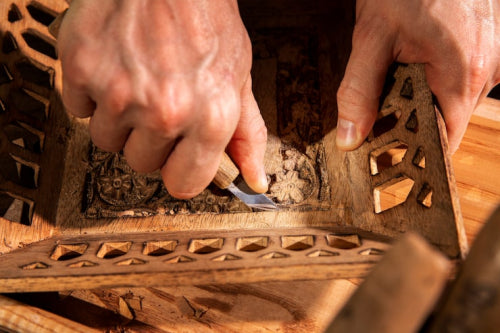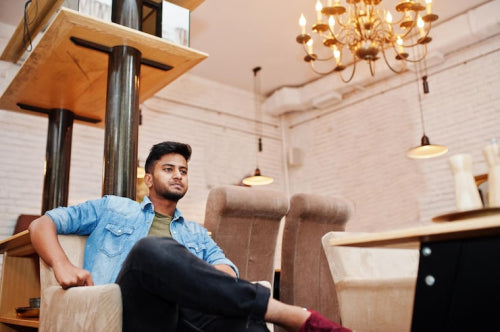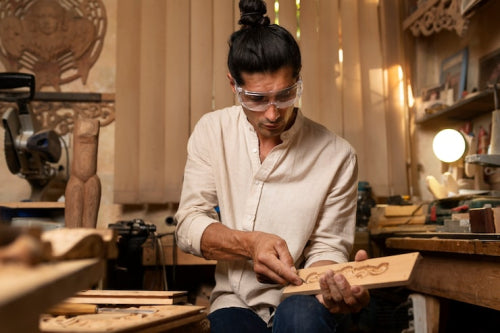Imagine stepping into a vibrant showroom in Mumbai, surrounded by the rich aroma of freshly varnished teak and intricately woven cane, where you're faced with a choice between a beautifully carved wooden armchair that tells tales of skilled craftsmanship and a set of perfectly uniform tables produced by advanced machinery in a modern facility. In the dynamic landscape of India's furniture industry, this decision goes beyond mere style it's a fusion of heritage, technological progress, and real-world functionality. With urban dwellings in places like Bangalore and Hyderabad becoming more compact while craving distinctive character, the distinction between handcrafted and machine-made furniture is more pertinent than ever. As we explore Handcrafted vs. Machine-Made Furniture: Understanding the Key Differences and What Works Best for Your Home, we'll delve into how these approaches intersect, particularly for emerging brands such as MMC Wood Creations, which delivers cost-effective, long-lasting items in cane, wood, and outdoor categories that seamlessly connect aspirational elegance with everyday utility.
Mass-market furniture lacks heart, filling rooms with bland, short-lived pieces. Frequent breakdowns spark frustration, as replacements erode style and sentiment. At MMC Wood Creations, Udaipur artisans shape heirloom furniture with enduring craftsmanship and cozy elegance, creating pieces that echo your identity, ensuring your home radiates warmth and timeless connection. Shop Now!
Defining Handcrafted and Machine-Made Furniture
At the core of India's evolving furniture sector, where time-honored woodworking techniques converge with state-of-the-art automation, two primary methods stand out: handcrafted furniture, meticulously shaped by artisans using inherited tools to form each detail, and machine-made furniture, engineered for consistency through high-precision processes that produce identical pieces en masse. Handcrafted items embody the essence of their creators envision an artisan from Jaipur meticulously interlacing cane to create an enduring outdoor chair, where subtle variations add unique personality, much like distinctive features on a portrait.
In contrast, machine-made furniture emphasizes operational excellence, employing technologies like CNC routers and automated lines to guarantee flawless joints and impeccable surfaces every time. This contrast holds significant weight in rapidly transforming urban centers. Tech-oriented young professionals in Bangalore desire eco-friendly wooden workstations built to endure, whereas tradition enthusiasts in Kolkata favor timeless cane seating reminiscent of historical estates. Spanning Pune, Ahmedabad, Chennai, and other key areas, the overarching global furniture market estimated at USD 745.65 billion in 2024 and anticipated to expand to USD 1,334.08 billion by 2033 with a compound annual growth rate of 6.8% mirrors this evolution, with the Asia-Pacific region holding a dominant 38.23% share in 2024, propelled by escalating incomes and urban expansion.
For MMC Wood Creations, an innovative entrant in this competitive arena, focusing on sought-after segments like cane, wooden, and outdoor furniture, integrating elements of both methods is not merely advantageous it's crucial. Their enduring styles avoid fleeting trends, providing robustness that conveys opulence at an accessible price point, ideal for households navigating Hyderabad's steamy climate or Mumbai's rainy seasons. This strategic positioning addresses common concerns about newer brands by emphasizing proven durability and classic appeal, ensuring customers invest in pieces that stand the test of time.
Emerging Trends in Furniture Manufacturing
Handcrafted furniture is undergoing a revival, positioning itself as a counter to throwaway culture rather than an outdated practice. Shoppers, frustrated with assembly-line disappointments, are increasingly drawn to bespoke items that exude personal flair. Within the global custom furniture market, valued at USD 40.25 billion in 2025 and projected to climb to USD 103.38 billion by 2034 at an 11.2% CAGR, this surge is fueled by a strong preference for individualized, premium-quality, and efficiently designed solutions that cater to both homes and businesses. Key factors include advancing urbanization, higher disposable incomes, shifting design preferences, and innovations in manufacturing like CNC machining and 3D printing, which boost production capabilities and tailoring options.
Shifting to machine-made options reveals a narrative of subtle transformation. Technological progress has made superior quality more accessible consider how 3D printing facilitates complex motifs previously exclusive to high-end markets, or how laser precision achieves impeccable results in reduced timeframes. The wooden furniture market, assessed at USD 618 billion in 2025 and forecasted to attain USD 989.8 billion by 2034 with a 5.4% CAGR, flourishes through such integrations, supported by initiatives like India's Pradhan Mantri Awas Yojana, which plans for 3 million additional residences in the 2024-2025 budget, thereby heightening needs for home upgrades.
Even in this domain, eco-conscious directions prevail: incorporating reclaimed resources and non-toxic coatings positions machine-made as a reliable partner rather than an adversary. Regional nuances enhance these developments. Jaipur's vibrant markets thrive on custom cane creations, where artisanal work prevails in upscale niches, attracting social media influencers hunting for exclusive aesthetics. Mumbai, as a pioneer in styles, combines mechanical productivity for towering residences with artisanal refinements for luxurious coastal abodes. This interplay of market forces allows MMC Wood Creations to navigate adeptly, with their perennial outlines resisting passing crazes while embracing functional needs.
Furthermore, trends highlight a growing emphasis on sustainability across both methods. In handcrafted realms, artisans increasingly opt for certified sustainable woods, aligning with global pushes for ethical sourcing. Machine-made production, meanwhile, leverages advanced techniques to minimize waste and incorporate recycled elements, responding to consumer demands for environmentally responsible choices. This convergence not only broadens appeal but also positions brands to capitalize on the expanding eco-market, where informed buyers prioritize longevity and minimal environmental impact in their purchases.
Real-World Examples and Applications
Consider MMC Wood Creations as a testament that novelty doesn't equate to unreliability. Entering a landscape wary of newcomers, they've established a distinct space with resilient cane seating that endures routine wear while radiating refined tranquility. In Bangalore, amid the fusion of professional and personal spaces due to remote setups, their wooden worktables merge manually smoothed textures with automated accuracy, converting limited areas into efficient havens. Patrons praise the lasting allure: eschewing ephemeral designs in favor of robust constructions meant for extended lifespans.
A similar narrative unfolds in Kolkata, where wooden pieces dominate, and purchasers emphasize green practices amid heightened environmental consciousness. MMC's exterior ranges, crafted from robust cane suited to the elements, adorn terraces along the Hooghly River, with artisanal accents such as delicate carvings transforming ordinary gatherings into evocative experiences. This isn't mere promotion; it's a direct reply to the luxury furniture market, pegged at USD 26 billion in 2025 and set to advance to USD 38.9 billion by 2034 at a 4.6% CAGR, driven by evolving tastes, increased earnings in developing areas, and accelerated city growth boosting needs for upscale living spaces.
These successes extend further. In Chennai's moist environments, MMC's mechanically produced wooden structures resist coastal corrosion, whereas Ahmedabad's business owners equip emerging ventures with adaptable configurations that grow alongside operations. The common thread lies in practicality over theory. Artisanal methods excel in focal elements like a legacy dining set in Pune's familial settings while automated approaches shine in coordinated arrangements, such as consistent exterior setups in Hyderabad's enclosed neighborhoods. MMC effectively unites these, demonstrating that an up-and-coming label can fulfill high-end desires without distancing budget-minded consumers.
Real-world integrations also showcase how these furniture types adapt to diverse lifestyles. For instance, in bustling commercial spaces across Mumbai, machine-made modular units provide quick, scalable solutions for offices, while handcrafted accents add a touch of sophistication to hospitality venues. This versatility underscores the value of hybrid models, allowing brands to cater to a broad spectrum of needs, from sustainable outdoor loungers in Jaipur to durable indoor sets in Kolkata, all while maintaining affordability and quality.
Key Challenges, Limitations, and Risks
Despite its allure, handcrafted furniture has inherent drawbacks rooted in its human element. Artisans in Jaipur may require extended periods to refine a cane pattern, postponing satisfaction in an era accustomed to rapid shipments. Expenses escalate due to intensive labor, elevating a coveted item to a financial stretch. Imperfections, such as natural wood variations or slight asymmetries, may deter those seeking uniformity, though enthusiasts view them as authentic enhancements.
Machine-made alternatives present their own hurdles. Standardization can lead to monotony, with replicated designs missing narrative depth. Subpar components such as engineered boards imitating premium timbers may degrade prematurely, with surfaces prone to wear. Personalization often feels supplementary rather than integral, disappointing city dwellers in Mumbai whose ideas conflict with production constraints. In Hyderabad, where affordability overrides artistry, this translates to impulsive buys that fail shortly after, sparking buyer remorse.
Business risks amplify these issues. For an emerging entity like MMC, overemphasizing manual processes could cause shortages in bustling Ahmedabad; excessive dependence on automation might erode the artisanal charm that captivates online audiences. Achieving equilibrium is complex yet essential, particularly in the wooden sector where hardwood commands a 61.9% portion in 2024, necessitating responsible procurement to navigate legal requirements.
Additionally, supply chain vulnerabilities pose threats to both categories. Fluctuations in raw material availability, influenced by global trade policies or environmental regulations, can disrupt production timelines and costs. For instance, restrictions on timber harvesting compel manufacturers to seek certified alternatives, potentially increasing expenses and limiting options for budget-conscious segments.
Opportunities, Efficiencies, and Business Impacts
In the face of obstacles, handcrafted avenues unlock substantial potential. Regional craftsmen in Chennai evolve into partners, generating premium collections that fetch higher prices envision MMC's cane swings customized with festive inscriptions for seasonal celebrations. Beyond revenue, this fosters communal ties, ecological responsibility, and leverages the 62% consumer inclination toward personalization that propels custom expansion. Enterprises harness green movements, such as utilizing recycled fabrics, converting sustainability into profitable ventures.
Machine-made strategies respond with volume advantages: accelerated cycles enable MMC to replenish Pune outlets swiftly, optimizing expenses for economical ranges without compromising sturdiness. In Ahmedabad and Mumbai, this mixed methodology broadens accessibility artisanal for elite markets, automated for wider audiences enhancing profitability in bedroom categories that secured 35.69% of the market in 2024. Consequences extend to improved liquidity, diverse customer bases, and for novices, established trustworthiness through consistent delivery.
The rewards manifest in adaptable offerings. MMC's classic wooden exterior ensembles, refined via machinery yet completed manually, encapsulate Kolkata's historical sentiment and Bangalore's contemporary vibe, illustrating that productivity and artistry can harmonize. Moreover, opportunities arise from technological synergies, where digital tools enhance handcrafted precision, or sustainable innovations in machine processes reduce environmental footprints, appealing to a growing demographic of conscious consumers.
Business impacts are profound, with hybrid models enabling scalability and innovation. By integrating trends like AR/VR for virtual customizations or modular designs that adapt to urban living, companies can capture larger market shares, particularly in Asia-Pacific's production-dominant landscape, where efficiency drives competitive edges.
Expert Insights and Future Outlook
Ultimately, the choice between handcrafted and machine-made boils down to individual narratives. For those pursuing exclusivity, the artisan's expertise provides profound value; for functional requirements, machinery guarantees widespread availability. MMC Wood Creations exemplifies this insight: offering economical indulgences in cane and wood that persist, with aesthetics that transcend fads and align with popular demands from Jaipur's open spaces to Chennai's coastal retreats.
Peering forward, signals from Jaipur and Chennai indicate escalating needs amid city expansions, with Asia-Pacific's vigorous furniture sector highlighting the merits of combined strategies. Authorities recommend audacious integrations. For enterprises aiming for growth, the path is evident shape tomorrow's standards, one deliberate creation at a time. In India's progressing residences, this harmony isn't elective; it defines modern sophistication.
Frequently Asked Questions
What is the main difference between handcrafted and machine-made furniture?
Handcrafted furniture is meticulously shaped by skilled artisans using traditional tools, creating unique pieces with subtle variations that add character and personality. Machine-made furniture, on the other hand, uses advanced automation and precision technology like CNC routers to produce consistent, identical pieces with flawless joints and surfaces. While handcrafted pieces embody the essence of their creators with distinctive features, machine-made furniture emphasizes operational excellence and uniformity.
Which type of furniture is more durable - handcrafted or machine-made?
Both handcrafted and machine-made furniture can be highly durable when quality materials and proper construction methods are used. Handcrafted pieces often feature robust construction meant for extended lifespans, with artisans focusing on time-tested joinery techniques. Machine-made furniture benefits from precision engineering and consistent quality control, ensuring reliable durability. The key factor is the quality of materials and construction standards rather than the manufacturing method itself.
Is handcrafted furniture worth the higher cost compared to machine-made alternatives?
Handcrafted furniture typically costs more due to intensive labor and the specialized skills required, but it offers unique value through exclusivity, personalization, and authentic character that mass-produced pieces cannot match. For those seeking distinctive pieces with individual flair and supporting traditional craftsmanship, the investment is worthwhile. However, machine-made furniture provides excellent value for budget-conscious consumers who prioritize functionality and consistency over uniqueness, making both options valuable depending on your specific needs and preferences.
Disclaimer: The above helpful resources content contains personal opinions and experiences. The information provided is for general knowledge and does not constitute professional advice.
You may also be interested in: Outdoor Furniture
Mass-market furniture lacks heart, filling rooms with bland, short-lived pieces. Frequent breakdowns spark frustration, as replacements erode style and sentiment. At MMC Wood Creations, Udaipur artisans shape heirloom furniture with enduring craftsmanship and cozy elegance, creating pieces that echo your identity, ensuring your home radiates warmth and timeless connection. Shop Now!
Powered by flareAI.co




